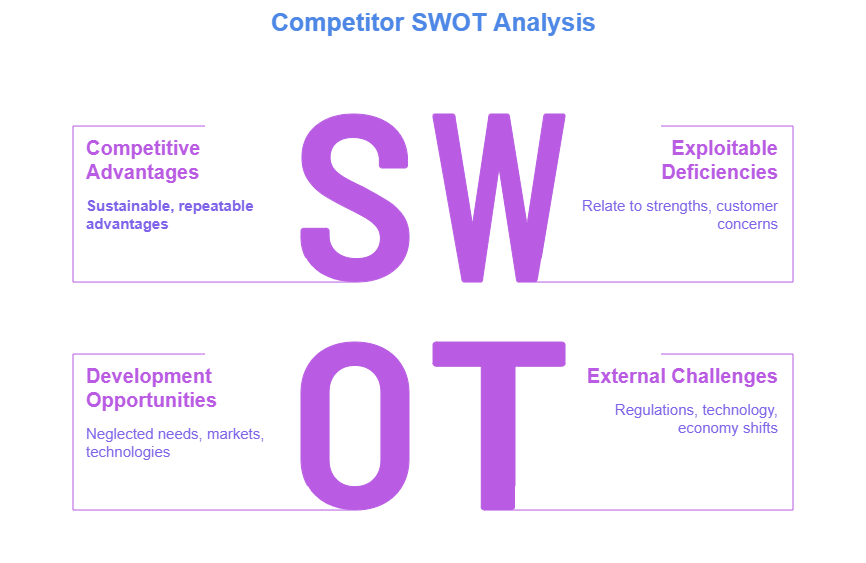Competitive Analysis: Stay Ahead in Any Market

The morning coffee will now taste bitter because here is some wake-up call you have been waiting to hear: 90 per cent of all startups fail, and what is the most frequent culprit? It is not about a shortage of funds, the product and market mismatch, or the wrong time. It is the utter lack of knowledge of their competition. These business people are like playing blindfolded chess and asking why they are always being checkmated by competitors they never knew.
By doing a competitive analysis in 2025 without trying other businesses, you could go to a gunfight armed with a butter knife and complain when things do not turn out in your favour. However, the twist is that most companies that believe they are undertaking competitive intelligence are just perving into the Instagram accounts of their rivals and dubbing it as market research.
This is the competitive analysis business, kids. And the difference between winning and losing is measured in information more than it is assessed in product quality. If it was about horsepower or features, you could overtake them. But it is about your enemy's intelligence, which is the key to survival.
What Is Competitive Analysis? (Spoiler: It's Not What You Think)
One thing should be made clear before moving into the heuristic of the competitive analysis that could transform the state of your business game. Creating competitive analysis does not mean replicating what your rivals are doing. That is being a follower, and followers do not set markets; they follow them.
Strategic intelligence with a purpose is real competitive analysis.
Imagine corporate infiltration, legal and, above all, much more high-tech. You are not only determining what your competitors are doing but understanding why it is being done, how successful it is, and, above all, their weak points.
Fundamentally competitive research is a system of general functions entailing identification, analysis and interpretation of your business competition and the overall competitive environment. It is competitive how you can turn competitive intelligence into a competitive advantage.
However, this is where most people go wrong; they believe competitive analysis is a one-time thing that should be done when starting a business or venturing into a new location. Wrong. Competitive analysis is something you do every day; it is similar to brushing your teeth or checking your phone, and things begin to stink after some time.
The Competitive Analysis Framework That Works
Any business strategy consultant will sell you their competitive analysis framework as the magic bullet to make everything work. And here is the reality:
The most superior competitive analysis framework is the one that will be used by you regularly.
With that said, what occurs after reviewing hundreds of competitive intelligence operations that work is that there is a pattern. The formula that eventually leads the companies to outmanoeuvre their competition all the time is as follows:
- Phase 1: Source Identification and classification
- Phase 2: Map of the market landscape
- Phase 3: In-depth competitive research
- Phase 4: Business-contextual SWOT analysis
- Phase 5: Strategic Action Planning
It is not another abstract scheme which is beautiful in PowerPoint presentations. It is a tested methodology in battle that differentiates the market leaders and the market followers.

Phase 1: Know Your Enemies (As well as Your Frenemies)
The initial point of how to do competitive analysis right is believing in the fact that not every competitor is the same. You have direct rivals who are your evil twins, indirect competitors playing in games nearby, and substitute competitors who are addressing the same problem your customer solved differently.
The direct ones are self-evident; they sell similar products to similar customers along the same channels. These are your cross-shopping competitions.
The indirect rivals are more difficult to trace and, at the same time, pose just as much threat. They are targeting the same customer wallet, just that they do it from a different perspective. Netflix was not competing just with Blockbuster; they were competing with everything, which took time for people when they were entertaining themselves.
Substitute competitors - are the jokers who can break a whole industry down overnight. Uber did not compete with the taxi companies; they competed with owning automobiles.
When performing competitive intelligence, please do not limit yourself to the strategic significance at the outset; instead, make it an extensive process. Identify the competitive picture using tools like Google Alerts, industry publications, and good old-fashioned customer feedback analysis.
Phase 2: Battlefield Design
Since we cannot discuss the next phase without mapping the battlefield, we cannot discuss our approach. After learning who you are fighting, you must learn the battlefield. This is when the market research tools will be your new best friends, and your competitive analysis framework will finally be able to demonstrate its full potential.
Market size and growth rates indicate whether you are gnawing over a growing pie or a shrinking crumbs. A competitive environment analysis may show you that you are the master of a shrinking market - well done, you are the master of a sinking ship.
Competition analysis is represented in terms of the market share, where you can understand the possessors of which piece of this pie and, hence, the space to grow. However, the catch is this: do not only look at the current market share. Consider trajectory. A competitor with a 5 per cent market share and a 50 per cent growth rate is dangerous compared to one with 25 per cent and zero growth.
Barriers to entry unveil the capability of new entrants to crash your party easily. Incumbents are safe behind high barriers; with low barriers, you had better get used to breaking into the business.
Intelligent Money will track these metrics continuously with the help of digital marketing analysis tools. It is not staying ahead when companies do these check-ups about the company's competitive position every quarter only.
Phase 3: Deep-Dive Competitive Research (The Magic)
This is where amateur hour stops and professional competitive Intel gets the ball rolling. You are not only analyzing what your competitors are doing, but you are also reverse-engineering their business strategy.
Product and Service Analysis: Keep comparing features at bay and study the customer journey. What competition is doing with its offerings? What are their issues of concern? What are the remedies that they are overlooking? The kind of competitor research you run must be able to tell what they are selling and what they believe the customers desire and are willing to purchase.
Pricing Strategy Intelligence: Pricing can be described as more of psychology than mere numbers. Is there perceived competition based on price, value or status? Are they doing freemium or subscription levels or pay per unit? Knowledge of pricing strategy tells us volumes about their cost of customer acquisition, their lifetime value assumptions and positioning in the market.
Marketing and Sales Analysis This is where you use your marketing competitive analysis abilities to the zest. Follow their content marketing, social presence, commercial advertising, financial commitment, and sales procedure. Competitor SEO tools like Ahrefs and traffic analysis tools like SimilarWeb are now handy.
But here is the secret sauce: They should not just keep track of what they are doing but also what is working. A competitor may be spending millions to spread awareness of their brand, which yields no returns. It is not smart; it is anti-smart.
Competitor Customer Experience Analysis Your competitive analysis must entail a customer experience analysis of your competitors. Register for their services, get onboarded, and use customer service. That personal knowledge is worth better than any report that you can purchase.
Phase 4: SWOT Analysis in Business (But Make It Strategic)
People are familiar with SWOT analysis, and most individuals apply it with hammer treatment when they should use scalpel treatment. Competitor SWOT analysis is not meant to capture obvious strengths and weaknesses but strategic opportunities and weaknesses.

Strengths Analysis: What Makes Them Dangerous? Instead of listing what competitors do well, find out why they do it well. Do they have technology, name recognition, presence in the distribution channels or efficiency? What is much more critical is whether it is repeatable or sustainable.
Weaknesses Analysis: Where They Are Wrong Weaknesses are the result of any competitor, but not all can be exploited. Highlight weaknesses that can relate to your strengths and the ones that are of concern to the customers. The worst social media of a competitor may be nothing compared to the sense that they are ineffective because their target customers are not social media members.
Opportunities Analysis: The White Space This is where competitive intelligence turns to competitive strategy. Which customer needs are the competitors neglecting? Which markets are they shying away from? Which technologies are sluggish to them? Such gaps open up as development opportunities.
Threats Analysis: The Storm Clouds Threats not only concern what your competitors may do to you, but they also deal with external forces that may intervene with the whole competitive environment—changes in regulations, technological advances, and shifts in the economy may transform the game altogether.
Phase 5: From Analysis to Action (Where Most People Fail)
This is the point where 80% of businesses fail. They perform outstanding competitive analysis, generate gorgeous reports—prompting a self-summary celebration for "work well done"—and then… nothing changes. Businesses end up in this cycle because they've confused movement with progress.
Action planning should result in a distinct advantage over your competitors—hence, transforming intelligence into an outright business edge. Your assessments must steer:
- Initiatives shaping new products
- Setting priorities for marketing messages
- Changes in pricing strategy development
- Alternative selection for market expansion
- Decisions concerning the allocation of resources
The best frameworks for competitive analysis include metrics that evaluate whether the strategic measures taken yield any results. If your competitive intelligence isn't acting as leverage to change your actions, you're getting it wrong.
The Modern Competitive Intelligence Tech Stack
This is where I talk about tools in one cohesive section. If you are doing competitive analysis in 2025 without a business intelligence tool, it is on par with trying to conduct surgery using nothing but a rusty spoon.
-
Customer Feedback Analysis: Trustpilot and G2 serve as platforms where customers tell your competition the truth. At the same time, Reddit and other industry forums expose unfiltered customer opinions alongside their pain points. Social media tracking tools capture brand sentiment during live discussions, while social monitoring tools capture conversations around the given topic.
-
Business Intelligence And Market Share Analysis: Crunchbase works seamlessly by funding, growth and strategic move tracking as well as paying attention to team growth along with their hiring patterns through LinkedIn Sales Navigator's hiring initiatives strategic drives focus on corporate intel driven planning into buzzwords. Macro trends, market sizing, and projected value come from industry-researched reports, leading to the macros targeting these micro-movements, which yield higher sales at a lower cost.
Each business has a different approach, which displays uniqueness, further distinguishing each company wherein focusing on every tool that possesses flare would be the wrong focus.
Competitive Analysis in Action: A Real-World Case Study

Lets discuss a B2B SaaS company that just about went bankrupt because it paid no attention to competitive intelligence and completely overhauled its industry standing through systematic competitive analysis.
This company suffered losses due to competition with a more recognized brand. Instead of competing directly, they focused on finding a gap with the help of competitive research that showed that mid-market customer service was poor.
Their competitive analysis proved that the big competitor was optimized for enterprise deals but created awful experiences for smaller customers. The support half-dedicated to these accounts was sluggish, onboarding processes were needlessly complicated, and flexible pricing options did not exist.
Our underdog company branded itself aggressively as "the mid-market specialist," which meant revamping customer journeys focused on ultra-fast and straightforward interactions. They ignored feature matching and provided solutions to issues their competitors neglected.
Within 18 months, 60% of the mid-market market share had been captured and were eventually bought by their previous competitor at an $8x revenue multiple.
The message is clear: proper implementation of competitive intelligence offers unparalleled benefits. Be sure it is done right.
The Future of Competitive Analysis
As we all know, competitive analysis is crucial for every business. What tends to go unnoticed is that it is changing quicker than many businesses can manage. This adaptability gap stems from how AI and machine learning revolutionize how competitors analyze each other.
Predictive competitive analysis will undoubtedly be the next big development in the field. Instead of only observing the competition, we are already working on forecasting what our competitors plan on executing next based on their hiring patterns, patent acquisitions, technology investments and other market signals.
Automated competitive monitoring systems perform much more efficiently than manual routine research intelligence gathering. This allows free strategy generation focused solely on action planning rather than information collection.
In our case, the companies that leverage good products along the winded plane of competitive, intelligent systems will have a definite edge over others.
Your Competitive Analysis Action Plan
Here is your homework: remember that competitive analysis is not a "project" but a capability. Companies that consistently outperform in their markets do not just do competitive research occasionally - they incorporate competitive intelligence into their DNA.
Start simply:
- Weekly: Ongoing direct competitive activity and customer observation
- Monthly: Deep-dive analysis into 2-3 of your primary competitors
- Quarterly: Complete competition landscape review and strategy update
- Annually: Comprehensive market assessment and a full competition re-positioning
The question is not whether you can afford to invest in competitive analysis but whether you can afford NOT to! In a world where competitive advantage is increasingly temporary and market disruption is constant, the only sustainable competitive advantage you have is knowing your competition better than they know themselves.
A lot of your competition is analyzing you as we speak. The question is: Are you analyzing them? Or are you holding out hope and playing with a blindfold? The game has changed. The winners will be those who understand the "new rules" before everyone else.
So stop stalking your competitors on social media and start building actual competitive intelligence. Your future market position depends on it.
Latest Posts

Tesla's No-Ad Strategy: Hype, Tweets & Community Power
How Tesla built a trillion-dollar brand with $0 ad...

BFSI & Fintech Marketing Campaigns: Trends, Insights, and Wh...
Fintech and BFSI marketing in 2025 is all about AI...

How Pharrell Williams Brought India to Paris Fashion Week fo...
Pharrell’s Louis Vuitton SS26 show brought Indian ...
